#disney movies are never going to be groundbreaking pieces of cinema with unique stories and deep messages
Text
i do think disney movies have gone down in quality (for many reasons) but i also think. perhaps. some of us are expecting way too much out of movies meant for. children
#and i am a firm believer that children’s media needs to be GOOD like u cant say it doesn’t matter bc its for kids#kids deserve good media#however#disney movies are never going to be groundbreaking pieces of cinema with unique stories and deep messages#like i think a lot of yall are way too nostalgic over the movies u grew up with#bc i promise u if u actually sat down and rewatched old disney movies u would find they are not NEARLY as profound as u remember#this is also why the way some people reacted to the barbie movie confused me so much#it was never!!! going to be some extreme feminist art house film masterpiece#it was always going to be a surface level you go girl!! barbie advertisement#and if you want to see films that do explore themes like that. maybe its time to break away from disney#maybe its time for u to explore film that wasn’t created to teach children basic lessons#maybe its time... to consume something other than family friendly pg capitalist toy ads#i say this 💗with love💗#also i know barbie movie wasnt disney and wasnt really meant for kids but it felt fitting in this convo#bc the expectations people put on that movie when it was literally!!!! a mattel sponsored ad were insane
3 notes
·
View notes
Text
If there’s a reason why we’re able to recall the story of Snow White from memory, and why said princess is usually depicted with short hair, a cute bow and surrounded by woodland fauna, look no further than Disney. Their take on the Grimms’ fairy tale is the prime example of pop cultural osmosis. Even if you’ve never watched Disney’s Snow White, it’s easy to recognize when a piece of work is borrowing from it or spoofing it. And I can definitely see why – not only is it going eighty-plus years strong, but its influence on nearly every Disney feature to come after it is a profound one.
The real story of Disney’s Snow White begins in the early 1910’s when a young Walt Disney saw a silent film version of the Grimms’ fairytale starring Marguerite Clark. The movie stuck with him well into adulthood. One night, well after he had established himself as an animation giant the world over, Walt gathered his entire staff of animators and storymen and re-enacted the tale for them in a mesmerizing one-man show. They were enraptured, but what he told them next struck them dumb – they were going to take what he performed and turn it into a full-length film.
In Tony Goldmark’s epic(ally hilarious) retrospective of Epcot, he performs a quick sketch he summed up as “Walt Disney’s entire career in 55 seconds” where Walt presents his career-defining ideas to a myopic businessman capable of only saying “You fool, that’ll never work!”. Considering how animation is everywhere today, it’s easy to forget that an animated film was once seen as an impossible dream. The press hawked Snow White as “Disney’s Folly”, and Hollywood speculated that it would bankrupt the Mouse House. It very nearly did. Miraculously, a private showing of the half-finished feature to a banking firm impressed the investors enough to ensure its completion.
Snow White is touted as the very first animated movie – admittedly something of a lie on Disney’s behalf. Europe and Russia were experimenting with feature-length animation decades before Walt gave it a try. But consider this: most animated films predating Snow White’s conception are either sadly lost to us or barely count as such by just crossing the hour mark. With all the hard work poured into it showing in every scene, with each moment displaying a new breakthrough in the medium, Snow White might as well be the first completely animated movie after all. Hell, it’s the very first movie in the entire history of cinema that was created using STORYBOARDS. A tool used by virtually every single movie put out today. If that’s not groundbreaking enough, I don’t know what is.
But is Snow White really…but why does it…can it…

“You know what? No. I’m not doing this teasing question thing before the review starts proper. OF COURSE Snow White is a masterpiece. OF COURSE most of it holds up. Let’s skip the middleman so I can explain why.”
After the opening credits we get the first of what will be many Disney leather bound books opening themselves to invite us into the world of the story. We’re informed that once upon a time there was a particularly Wicked Queen (nicknamed Grimhilde in promo features and the comics) who had a serious narcissistic personality disorder. Every day she consults her Magic Mirror™ to see who’s the fairest one of all and takes pride in being repeatedly told she holds said title. In the meantime she bullies her younger, prettier stepdaughter, the princess Snow White, and gives her the standard Cinderella treatment in the hopes that endless drudgery will wipe out the competition.
One fateful morning, however, the Mirror informs the Queen that she’s been bumped down to runner-up. She susses out that it’s Snow White who’s taken her place after the Mirror describes the newcomer as having “lips red as the rose, hair black as ebony, [and] skin white as snow”, but maybe the Queen is projecting here due to her extreme jealousy. Going by those three traits the Mirror could be describing almost anyone on the planet.

Care to narrow it down a bit, buddy?
Now if you consider yourself a feminist or at the very least have progressive views regarding women, I know what you’re thinking – just another example of the patriarchy pitting shallow female stereotypes against each other, right? Well in a manner of speaking, yes. There’s plenty of evidence that the Brothers Grimm held some odious misogynistic beliefs that stemmed from a bad combination of the era they lived in, outdated religious teachings, and their own experiences with the opposite sex. It shows in their second fairy tale revisions – the heroines are naïve bimbos in need of a man’s rescue, and the villains are evil stepmothers and witches who happen to be hideous 99% of the time – and those views have been reinforced in our society thanks to those particular iterations being passed down to today.
Here’s my way of viewing the central conflict: The Mirror’s news is a wake-up call that Snow White is coming into her own as a woman and princess. That means marriage to a prince and the end of the Wicked Queen’s rule. Snow White will have all the power and adulation while the Queen is forced to step down and become another footnote in ancient royal history. Up until now the Queen has gone out of her way put down her pretty young opponent with petty cruelty because there’s nothing stopping her; but when faced with the inevitable, she unflinchingly opts to take more drastic measures so she can keep the throne.
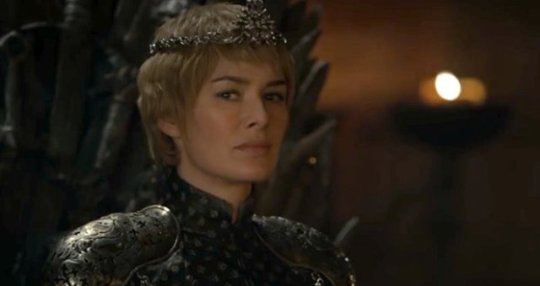
If it weren’t for the fact the Queen’s unofficial moniker is Grimhilde and her transformation scene reveals a head of black hair, I’d suspect her real name was Cersei Lannister.
You also have to remember that the Queen takes the term “fairest” at face value. The Queen is beautiful, sure, but it’s a glacial beauty – cold, unfeeling, and nothing beneath the surface. All she cares about is looks and power. You’d have to be a pure loving soul or Woody Allen find something worthwhile in her. Snow White is beautiful too, though it’s her kindness and fair treatment of everyone that garners her the title of “fairest one of all”, not her appearance.
Speaking of, we follow that scene with Snow White (Adriana Casselotti) dressed in rags cleaning the castle courtyard. She shows her bird friends her wishing well and sings “I’m Wishing”, where she reveals her wish for her one true love to show up.
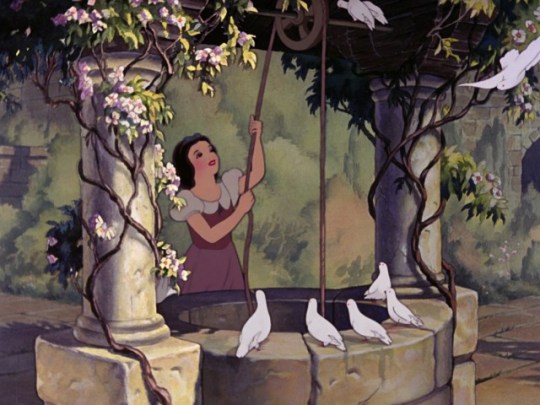
Confession time: In childhood the title of my favorite Disney princess was neck and neck between Belle from Beauty and the Beast and Snow White. I’ve already discussed at length why I adore Belle, so I suppose I should do the same for Snow.
…turns out it’s more difficult than I thought.
For as long as I could remember, I was surrounded by Snow White paraphernalia – tapes, toys, dolls, music, games, artwork, bed sheets, I can even recall the ice show. Snow White is ingrained into my early years. It more than likely has to do with the timing of its brief return to theaters and first VHS release between 1993 and 1994, right at the peak of the Disney Renaissance, so I experienced Snow White-mania right alongside Lion King-mania, Beauty and the Beast-mania and various other Disneymanias that were rampant at that time.

Even this one, embarrassingly.
As a result, I idolized Snow White as much the other princesses of the time, right down to making her the character I dressed up as the most for Halloween. I suppose what drew me to her was inherent kindness, ability to make friends with everyone, and her voice. Yes, I admit it. I don’t find Snow White’s warbling to be as irritating as everyone says it is. Maybe I’ve listened to it so much that I’ve grown immune. Then again I am that one Disney fan who doesn’t loathe It’s A Small World with every fiber of their being so maybe I should question my own tastes more.
Now as an adult with a critical eye who can put nostalgia behind me when necessary, is there something more to the character of Snow White that’s worth appreciating as much as the more-fleshed out princesses of the Renaissance and current Revival period?
I accept that I’m in the minority on this one, but I firmly say yes.
I know what you’re thinking – all Snow White does is smile and sing while she slaves under the Queen and the dwarfs and dreams of a handsome man to come carry her away, so I should turn in my feminist card for daring to suggest she’s a good character and role model for girls, right? Consider this: like Cinderella after her, Snow White’s happy nature and songs are her ways of coping with her unpleasant situation. It keeps her spirits up and in turn she tries to spread that positivity to others who need it as well. She refuses to let the Queen’s negativity turn her as sour as she is. All the little things Snow White reveals in what she does – her patience, pride in her work, healthy emotional balance, drive to help others, and warmth towards those smaller than her (in both a figurative and literal sense) – are all signs that she is capable of being a far better and beloved ruler and all around person than the Queen is. Plus, her reason for wanting to find love is two-fold: not only is she looking for someone with whom she can share a unique emotional understanding bond – which is something most every human craves – but it’s the also best possible means for her to escape from her stepmother’s abuse. Like I said earlier, once Snow White gets the ring, she gets to rule.
And what’s wrong with having a princess who can run a practical household? One could argue that it’s an example of traditional female roles desired by an oppressive patriarchal society on full display, but you want to know why millennials are called out for being lazy? Because baby boomers have cut out classes that teach things young adults actually need outside of school like how to properly cook and do laundry and pay your taxes since those weren’t seen as “essential enough to education”. So I have to admire a princess who, while not the most “progressive” of the bunch by today’s standards, is willing and able take care of herself and others when it comes to basic everyday needs. I think TheBrutallyHonestMom summed it up best in her post defending Snow White:
When we denigrate what Snow White accomplishes at the dwarfs’ cottage, when we rename her accomplishments to make them sound more impressive, more official, more valuable—management, administration, domestic CEO, sous chef, hospitality specialist—what we are really doing is saying that we don’t value the truly valuable work that she and so many other stay-at-home individuals do. Those words are a microaggression against what have traditionally been feminine roles, an attempt to align them with a patriarchal worldview where only those with the biggest titles and fattest paychecks matter. Snow White is domestic. She is a maid. She is a mother figure. She does take on the womanliest of the womanly roles. To claim that adopting these roles (and being good at them) somehow makes her a poor role model for my daughters is not a failure of Snow White’s imagination. It is a failure of ours.
Then there’s the matter of her actress too, which I can’t stay silent about. A few years ago it was revealed that in order to preserve the illusion of Snow White as a real character (a good many years before the company applied that same logic to their character performers at the theme parks I might add), Disney forced Adriana Casselotti to forego her screen credit and never take on another acting role again, essentially robbing her of a career. She only managed to appear in It’s A Wonderful Life and The Wizard of Oz because hers were uncredited minute parts. Casselotti had no regrets about choosing Snow White over a promising show business vocation, but I still call bull on the matter. If this kind of thing happened today, people would not stand for it, character illusions or not. There’s also crazy double standards since all the actors who played the dwarfs got to keep on acting; Sneezy’s voice actor was in Fun and Fancy Free for crying out loud! I love ya Walt, but that is one dick move. So if you’re a detractor cheering that you never have to hear Casselotti’s voice beyond this movie, keep in mind that’s all because of one man silencing her for the sake of his business.
So, Snow White. She cooks, cleans, delegates, teaches, loves, domestically kicks ass, and her behind the scenes story makes a strong case for the Time’s Up movement. Any questions?

“Yes. You’re over 2000 words in and we haven’t even gotten to the dwarfs yet. Plan on getting off that soapbox sometime this decade?”
Snow’s singing attracts the attention of a handsome Prince (Harry Stockwell) passing by on his horse. But his forwardness startles the shy girl and sends her sprinting up to her room. He charms her out to her balcony by singing his one song in the feature…”One Song”. You gotta love it when the title matches the tune perfectly.
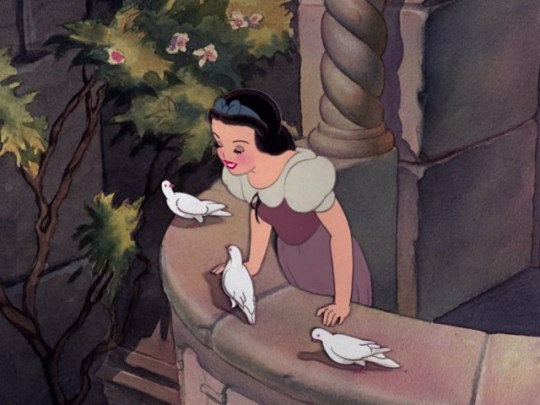
“Wherefore art thou Prince? Deny thy father and refuse thy name!”

“Sure I’ll gladly refuse my name – if I had one, that is.”
All joking aside, I have a soft spot for this scene. Stockwell’s voice has this old-time Broadway/operetta quality I’ve always liked, the lyrics are unironic purple prose that still feel genuine, Snow’s little excited gestures are adorable, and it’s framed beautifully. This is what got it into my heard early on that the most romantic gesture anyone can make is serenading someone from beneath their balcony.

“Too bad you’re technically in a long distance relationship.”

“I know. Propping up a phone beneath your window just doesn’t have the same effect.”
Snow returns his affections with a kiss delivered via a dove and departs the scene with one hell of a pair of bedroom eyes, especially for a Disney character.
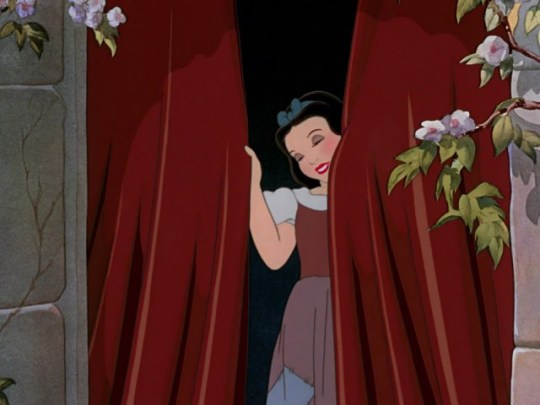
Daaaaaamn, girl! You already got him hooked, no need to gild the lily!
Unbeknownst to either of them, the Queen is watching overhead; Snow catching the eye of Prince Charming is what finally pushes her to take further action. She summons her Huntsman –
– to bring Snow White out into the forest and do away with her. Brief as this scene may be, there are two things I really like about it. First, the gravity. The Huntsman reacts with horror on being told what he must do, foreshadowing his eventual turnaround, yet with an icy hiss of “Silence!” and a short reminder of the price of failure, the Queen goads him back into line. We don’t know what the penalty for insubordination is, but it’s implied to be pretty nasty if she’s able to convince him otherwise with just a few words. Second, the Queen’s other demand. In the original fairytale, the Queen requested Snow White’s liver, lungs and heart so she could eat them and inherit her stepdaughter’s comely attributes.
youtube
But here in the film, she only wants the heart, and not for lunch. The Queen wants to keep it as a trophy. She even has a disturbingly appropriate box for it at the ready.

Proof that she really puts the ‘grim’ in ‘Grimhilde’.
Snow White, now dressed in her iconic yellow and blue dress, goes out flower picking with the Huntsman waiting not far behind. She spies a lost baby bird, and the moment she turns her back to help it, the Huntsman moves in for the kill. It’s framed like the murderer creeping up to their next victim in a scary movie, slowly building up to the moment he confronts her, with tension you could cut with a – well, you know.

Ultimately the Huntsman is moved by the princess’ humanity and can’t go through with the deed. Instead he reveals the Queen’s plot and pleads her to run, run away, Snow, and never return. Terrified, Snow White flees into the forest where her fears magnify her surroundings. Brambles become gnarled outstretched hands, logs are hungry snapping crocodiles, and there are eyes everywhere, always watching, boring into her every place she turns.
I should note that while developing Snow White, the Disney studio became something of an art college with fine arts and film study classes offered to the staff in order to hone their craft. Some of the movies they studied were horror flicks from the pre-Hays Code era, classics directed by the likes of James Whale and F.W. Murnau. The results speak for themselves. Scenes like this and the Queen’s transformation are why I consider Snow White my very first horror movie. The frightening imagery and darker themes all hide beneath a veneer of Disney childhood innocence. Like a proto-Pan’s Labyrinth, the terror as much psychological as it is fantastical.
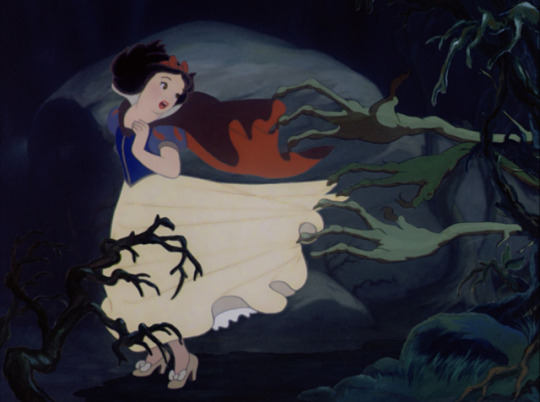
A young Sam Raimi watched this and vowed one day he’d make those trees even more terrifying and bad-touchy.
This scene is also the source of one of the most famous stories to come out of the film’s creation. During the planning of the part where Snow falls backwards through an open-mouthed cavern into a lake, one of the animators cried out in terror “Won’t that kill her??” And the whole room fell silent. They reached the point where they no longer thought of Snow White as a cartoon but as an actual person, something that had never happened before. That was the moment where they were officially, as Ben Vereen once put it, on the right track.
Overwhelmed, Snow White collapses in tears. She’s brought back to her senses by the usual cuddly forest inhabitants inexplicably drawn to female royalty in need of assistance. Of course, being the ever-thoughtful soul that she is, Snow apologizes for startling them and making a fuss over how afraid she was, once more putting others before herself. She bonds with the animals through the uplifting “With a Smile and a Song”. Then she spends several minutes talking to them and making plans for the future all in rhyme. I confess it’s one of the weaker moments of the movie, showing that the studio’s transition from the Silly Symphonies to full-fledged filmmaking hasn’t completely been made yet.
The critters lead Snow to a quaint cottage in need of a good cleaning service. Assuming the miniature-sized furniture means the inhabitants are orphaned children, she decides to surprise them by sprucing up the joint, hoping her act of kindness will make them forget her breaking and entering and they’ll let her stay. Said cleanup time is underscored by one of the more upbeat tunes in Disney’s songbook, “Whistle While You Work”. Like Mary Poppin’s “A Spoonful of Sugar” it’s all about finding joy in the little things that make the work go by quicker.
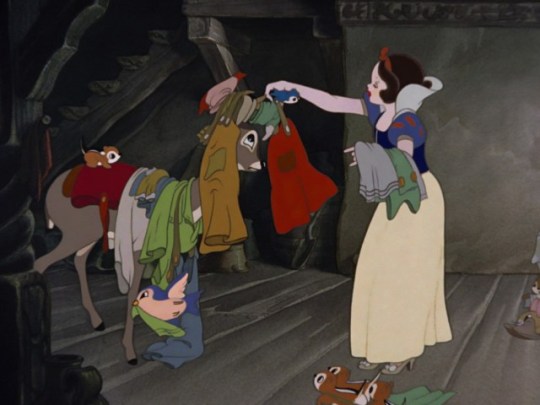
“Here’s the last of the underwear, Bambi. And try not leave any ticks in the laundry this time!”
But as we all know, the cottage belongs not to seven children, but seven little people who work as jewel miners, all the while singing that famous mining song –
youtube

“No, the one sung by dwarves.”
youtube

“Seriously?!”
All joking aside, Heigh-Ho is the best song in the movie, no contest. Easily the catchiest tune here if not the entire Disney canon. If it can keep a theater full of gremlins occupied, it’s doing something right.
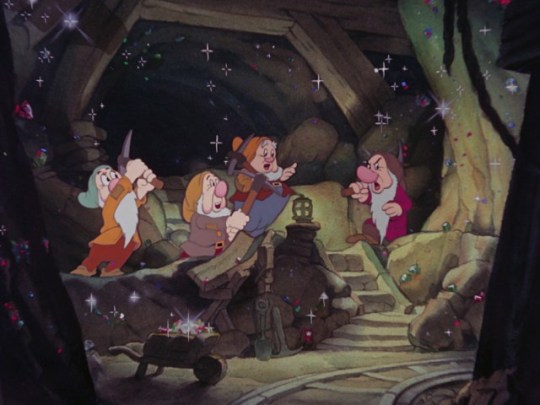
Sure, they whistle while they work for now. But once they find the Arkenstone it’s all downhill from here.
And let’s not kid ourselves, the dwarfs are the real reason why we keep returning to Snow White. Their quirk-matching names and designs make each one memorable, they’re endlessly entertaining, and they’re the characters that come the closest to having some form of arc. The group is a prime example of the illusion of life that is animation, exaggerated to a degree that they’re still believable in their movements and mannerisms. Dopey especially works well in this regard, a wonder considering much of his character was developed by happy accident. When an actor suitable enough couldn’t be found, they made the decision to simply mute him. Like much of Disney’s favorite animal sidekicks, they based his personality around that of a lovable dog, though I’d be lying if I didn’t see some Harpo Marx in there as well. As a result, his childlike playfulness and comic timing is up there with Chaplin’s Little Tramp. His hitch step was also an unexpected boon; after animator Frank Thomas put it in one of his scenes, Walt liked it so much that he insisted all previously animated footage of Dopey be redone to include that step. Incidentally, Frank’s popularity among the animation staff reached all-time lows after that announcement.
Snow White flops down for a quick nap on the beds upstairs just as the dwarfs return home. What follows is them sneaking about their now suspiciously squeaky-clean cottage and further establishing their personas through a series of finely-tuned gags (Walt paid five dollars for every good joke his guys could come up with, and this was when five dollars could take you out to dinner and a show). Dopey is elected to check the bedroom and he comes to the conclusion that Snow’s sleeping form is a monster. The dwarfs work up their courage to go kill the beast themselves only to realize in the nick of time that it’s just a harmless girl. But Grumpy, the clear-cut misogynist in the group, isn’t keen on having a “wicked-wiled” female refugee in their abode and shamelessly yells “Let ‘er wake up, she don’t belong here no-how!”
Snow wakes up and instantly charms over everyone except Grumpy as they introduce each other. The dwarfs are shocked and terrified to learn the Queen has put a hit out on her. Grumpy in particular declares the Queen is a powerful witch skilled in the black arts, which is true, and it raises a potent question. Is her magic common knowledge throughout the kingdom, or is it mere speculation? If it’s the former, how did that come to be? What happened to Snow White’s father the king anyhow? All this could make for a very interesting –

“You know what, never mind, forget I said it -“

“Too late! Jenkins, write that down! Bob’s gonna love it!”
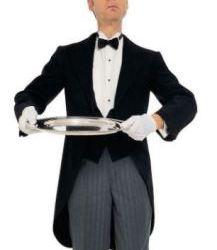
“Very good, sir. Shall I pre-heat your crack pipe in preparation for the first draft writing session?”

“Does the Academy loathe streaming services? Hop to it, my man!”

“Hey, I thought you left that jerk to go work for Don Bluth.”

“Shh! I jumped ship after A Troll in Central Park and came back under a new identity. I couldn’t pass up the bankroll Disney’s been on since 2009.”

“Mum’s the word.”
Grumpy’s certain that they’ll be in the Queen’s crosshairs once she learns they’ve been harboring Snow White and demands they kick her out at once. But Snow White stands up for herself and says she can take care of the house for them if they let her stay. Just like Belle offering herself in her father’s place, no one corners Snow into the position of housekeeper. She’s the one who puts herself out there, listing all her best qualities like she’s on an interview. It’s only when she does so (and also mentions she can bake a mean gooseberry pie) that the dwarfs overrule Grumpy and declare she’s welcome in their home.
Yet even when all is said and done, Snow makes it clear that if she’s the one doing the work, then the dwarfs must play by her rules. Immediately following their acceptance, she goes into full Team Mom mode, insisting they improve their manners and wash themselves before dinner’s ready. Doc attempts to get around it by saying they cleaned up “recently”, but despite her sweet nature, Snow won’t let them walk all over her. She does a cleanliness inspection that makes the dwarfs almost as bashful as Bashful himself, and even gets a good bit of sarcasm in (“Why Doc, I’m surprised.”) The dwarfs washing themselves is another one of those Silly Symphony-esque filler scenes, but at least it gives us more time for their fun shenanigans; though I have to wonder if dog piling Grumpy and half-drowning him takes it too far.
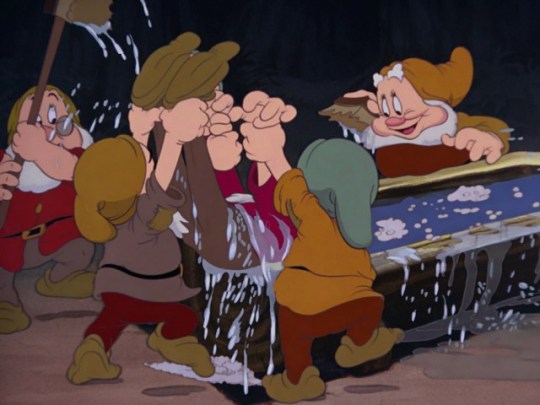
“Where’s the money, Legrumpski? Where’s the fucking money??” “It’s down there somewhere, lemme take another look.”
Back at the castle, the Queen is showing off her newly acquired bodily organ to the Magic Mirror while demanding he validate her preconceptions of who’s fair and who’s not. Alas, the Mirror tattles on Snow White’s location and reveals that heart belonged to a pig, which I’ve got to say I’m glad they didn’t show how the Huntsman got ahold of.


Infuriated, the Queen storms down to her secret lab (and no, there’s no wrong lever scene. I’m disappointed too). She brews up a potion made up of ingredients like scream of fright, a thunderbolt and partially hydrogenated dimethylpolysiloxane which will completely transform her into a disguise nobody could suspect her in, an aged peddler woman.
Was I afraid of this scene way back when? Of course, but it was one of those rare moments where I didn’t want to look away either. Here we have a woman dangerously obsessed with beauty becoming the very thing she loathes in order to sate her implacable desires. Not only that but in this disguise she’s able to set loose the insanity buried deep beneath her frigid calculating exterior, grinning and cackling like the witch that she is. The Queen never smiles once when she’s in her true form. But once she’s the old Hag and it’s all cackling and gap-toothed smiles, it’s extremely unnerving.
Case in point.

“Anyone else miss the creepy fade to black where the villain’s eyes remain for a few seconds? Disney needs to bring that back.”
Major props to Lucille LaVerne, who gives a bone chilling and utterly unrecognizable performance as BOTH the Queen and the Hag. She made the switch from one role to the next by removing her false teeth between recording sessions. In doing so she gave us one of the great Disney villain performances.
The part where she preps the infamous poisoned apple does undercut some of her menace, however. The Hag is supposed to be sharing her scheming with a cowardly raven, but due to how much she stares directly into the camera while monologuing, it comes off as directly addressing the audience, like we’re watching her in a play. It’s not just the Silly Symphony style of storytelling creeping in, it’s melodramatic semi-vaudevillian theatrics that early Hollywood was moving well away from at this point. And again, what’s with the sudden speaking in rhyme?
At the last moment the Hag looks up a possible antidote to the poison and learns that it’s Love’s First Kiss. However she scoffs at the notion that Snow White can be saved because she’s counting on the dwarfs believing the princess is dead and burying her alive.

“For those of you who claim Disney waters down fairy tales into saccharine pap, I point you to Snow White.”
And it doesn’t end there. As the Hag leaves the dungeons, she passes a cell where a skeleton is sprawled out between the bars, reaching for a water pitcher. It’s bad enough to imagine this poor soul dying of thirst, spending their last moments with salvation just out of their grasp, but the Hag openly mocks the skeleton and kicks the pitcher aside. If that’s not a deciding irredeemably evil factor moment, it comes pretty darn close.
This would have also tied into an important but ultimately scrapped sequence where the Queen kidnaps the Prince, locks him in the dungeon to keep him from saving Snow White and torments him by detailing her elaborate scheme.
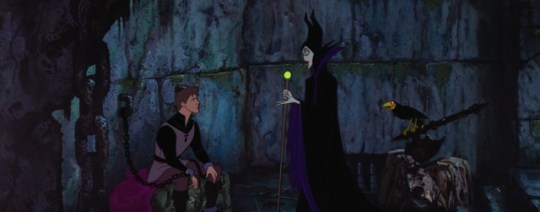
This sounds vaguely familiar…
Depending on which pitch you’re reading, the Prince refuses the Queen’s offer of marriage, and she enchants the chained-up skeletons of other scorned suitors to dance in an extremely misguided attempt keep him entertained while she’s out, or floods the dungeon to drown him. He makes a daring escape and rides to the rescue on horseback.
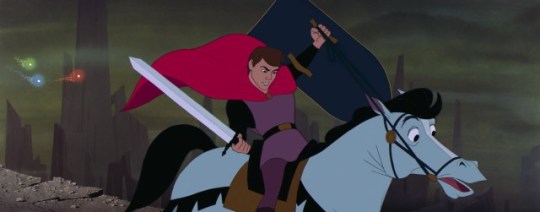
Again, vaguely familiar…
Unfortunately we had to wait twenty-plus years for this to happen because the animators weren’t confident in their abilities to create a believable male character. This is why the Prince appears only in the beginning and the end of the movie (and by extension why the Cinderella’s Prince is barely in that feature as well). When it came to making Snow White look realistic, they subtly incorporated some rotoscoping in a few places (I’d call it cheating but it’s difficult to tell where it begins or ends because she looks that good eighty years later). But I guess it just wasn’t worth the effort to do the same for her love interest, who doesn’t even get the dignity of an official name (fans go back and forth between Florian and Ferdinand). He’s reduced to a deus ex machina – which to be fair is exactly how he was treated in the fairytale. The movie has the slight advantage over that, however, by setting him up before he arrives for that wake-up kiss.

“And now it’s time for Silly Songs With Happy, the part of the review where Happy comes out and sings a silly song. Today’s interlude, appropriately titled “The Silly Song”, features choreography which has gone on to inspire many other Disney musical sequences dating as far ahead as the 70’s.”
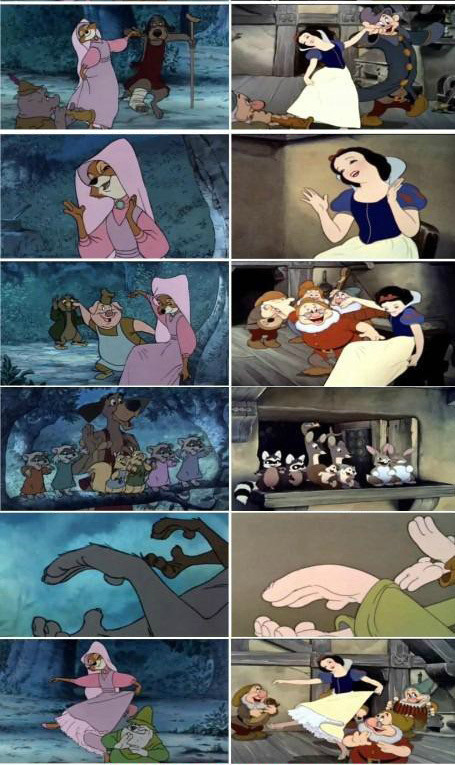

“Hold it!! It’s just the exact same movements with the Robin Hood cast grafted over them!”
“Is there a problem with that?”

“Well…no…it’s just a bit distracting when you finally notice it. I mean I love Disney’s Robin Hood, but boy did they take the main character’s attitude towards stealing to heart when it came to the animation.”
And yes, “The Silly Song” itself is fun too. It’s one of the less remembered Disney tunes, though I have fond memories of it due to its inclusion in the Sing-Along video lineup. The decision to have it follow the Hag’s unsettling introduction makes perfect sense; I could imagine audiences experiencing it for the first time needed a bit of a breather after that.
I guess I should mention the musical number we could have had instead of this one, though. “Music in Your Soup” was a similarly lighthearted song that was fully recorded and animated before it was ultimately cut. It was expertly animated, featured more dwarf-Snow White interactions, and it also closed up a plot hole involving a bar of soap Dopey swallowed earlier. Still, it didn’t add much to the story overall and it disrupted the flow, and keeping both that and “The Silly Song” would have been superfluous; so as much as I like “Music In Your Soup” I think they made the right call in sticking with “The Silly Song”.
After the dancing, Snow regales the dwarfs with a love story, though they quickly figure out she’s talking about herself and her prince. She dispenses with the self-insert fanfiction and sings the movie’s eleven o’clock number “Someday My Prince Will Come”. Bawl all you want about setting women’s rights back a decade, it doesn’t change the fact that it’s still a lovely song, even without Casselotti’s vocals. In fact, much of the movie’s soundtrack has been a go-to for jazz artists through the decades ranging from Miles Davis to Dave Brubeck. The pure simplicity of Larry Morey’s lyrics and Frank Churchill’s melodies are ripe for riffing on. Virtually every cover I’ve found succeeds in the impossible task of measuring up to the original in some capacity. The action in the song itself is subtle and restrained, mainly focusing on the dwarfs’ reactions. It’s not only good storytelling, but a clever way to get around showing more of Snow White than the animators could handle; she was already tough enough to animate even with rotoscoping.
Snow realizes how late it’s getting and ushers the dwarfs to bed; however Doc and the others try to behave like gentlemen and allow her to sleep upstairs while they take up whatever space they can fill on the lower floor. It goes to show how much her kindness and politeness has had an influence on them, at least while she’s around. Them taking up whatever sleeping space they can find on the ground floor is an excuse to squeeze more gags in, but I’m fond of how it lets us wind down and take in this cozy atmosphere.
The next morning before they head out the dwarfs warn Snow White to beware of strangers. Even Grumpy can’t help but show concern in his own gruff tsundere way. It’s little touches like this that reveal Snow White’s unwavering compassion is chipping away at his chauvinist attitude and he really does care about her after all –
Hang on, they couldn’t spare ONE dwarf to stick around and keep an eye out in case the Queen does drop by? They’re really think the Queen isn’t going to make another murder attempt as soon as possible? They sadly must, because no sooner do the dwarfs heigh-ho off to work than the Hag creeps up like a meth user turned Jehovah’s Witness.
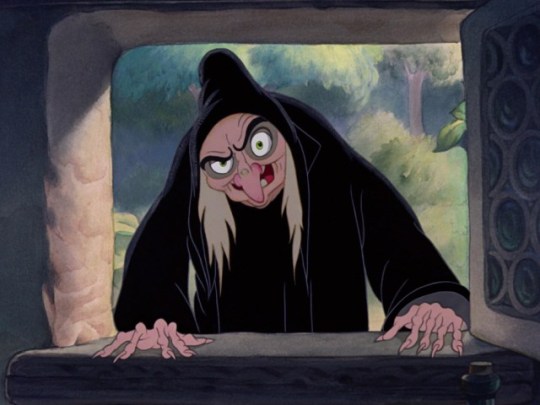
“Hello, my name is Elder Grim. Would you care to learn more about our lord and savior Chernabog?”
After the animals fail to communicate the obvious danger, they fetch the dwarfs for help. Meanwhile the Hag has convinced Snow White to let her into the cottage and show off her “magic wishing apple”.
Already I can hear the slapping of a thousand facepalms through my screen. I get why, but there’s something about the situation that feels strangely relatable. The Queen is fully aware of Snow White’s gentle, trusting nature and knows how to take full advantage of the girl. Snow isn’t all smiles and open arms though. There’s a split second of regret the moment she divulges she’s by herself, and as the Hag literally corners her into tasting the poison apple her body language gives away how uncomfortable she is. Even the cottage itself grows darker and claustrophobic, mirroring her trapped state. Snow White knows there’s definitely something off about this stranger, but there’s the downside of her kind personality. She can’t bring herself to kick the old lady out no matter how wrong this scenario inherently feels.
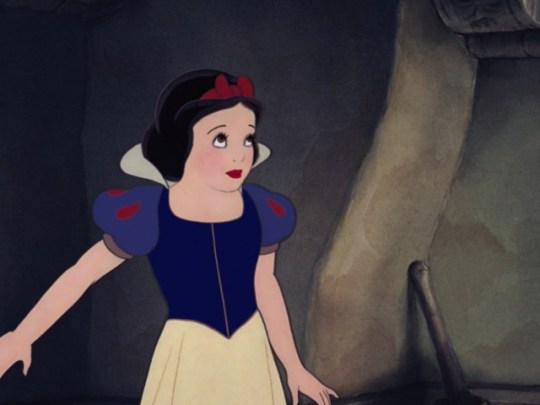
“Just keep smiling and slowly reach for the mace.”
Ultimately the Hag coaxes her into tasting the apple. Every breath leading up to it is dramatically intercut with the dwarfs led by Grumpy (further proof Snow White really has gotten through to the old softie) racing back to the cottage.
Do you want to know why the original Texas Chainsaw Massacre is considered one of the scariest movies of all time? Because for all its promise of a gory spectacular, the violence is deliberately kept offscreen. Our imaginations fill in the blanks and come up with even worse terrors than they could possibly show. Snow White’s poisoning works on that logic. All we hear is her gasping and groaning as the Hag gleefully looks on, ending with the most cinematic shot of the film.

If you’re still convinced Snow’s a dunce for biting the big apple, trust me, it’s a vast improvement over the original. The Queen showed up in disguise three times to kill Snow White with varying methods: strangulation by laces, a poisoned comb, and of course the apple. This was cut down to the last one for obvious reasons – not only would the story be repetitive and extremely padded if they remained, but it makes Snow White look like an idiot for falling for the same trap thrice in a row. The only time I’ve ever seen the inclusion of all three murder attempts work is in the anime The Legend of Snow White (which despite the laughably bad English dub is worth checking out). By the time the Queen comes around with the apple in that instance, Snow White is well aware of who she’s dealing with. But she plays along because the Queen has turned the kingdom to stone, and the only way to break the curse is by taking the bait and destroying her staff while she thinks she’s down, thus turning what was once an act of naivete into a heroic sacrifice.
The Hag exits the cottage feeling confident in who’s the fairest now just in time for the dwarfs to show up. They chase her through a thunderstorm up a cliff side. Literally trapped between a rock and a hard place, she attempts to dislodge a boulder and crush her pursuers. But Zeus is having none of that and a lightning bolt strikes the cliff, plummeting the Hag to her doom.
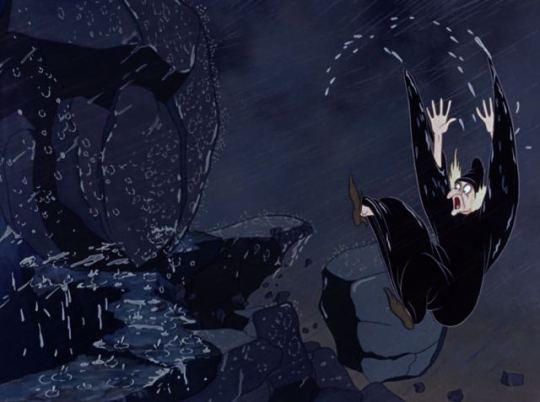
To quote Linkara, “Thus the origin for ‘Rocks fall, everybody dies’.”
And in case you’re still thinking she could have survived that drop, even with that boulder tilting over after her, the vultures that have been tailing her since she left the castle begin circling lower and lower over the place where she now lies. A chilling, subtle way to show they’re getting a meal after all.
We fade to a wake the dwarfs are holding for Snow White, complete with organ music and weeping – LOTS of sad, silent, motionless weeping. Poor Grumpy gets the worst of it. One can only imagine the tsunami of emotion he must have felt coming home to see that she was making a pie just for him. Like “Someday My Prince Will Come” it shows how restraint can be an asset in acting for animation. Considering how it’s very much like a real-life wake and just how much everyone believes Snow White is truly dead, this was a tough scene to get through.
The seasons pass and we’re told through title cards that the dwarfs couldn’t find it in themselves to bury Snow White, so they built a glass coffin and kept constant vigil along with the depressed forest animals.

“Clearly the idea of watching her slowly decompose over time never crossed their little minds.”
The funeral on top of the wake keeps piling on the sadness. We’re used to animated features moving us to tears, but you have to remember for audiences back then this was an entirely new experience because no animation dared to get this heavy. Think about it: Shirley Temple, Charlie Chaplin, the best and the brightest of Hollywood who poo-pooed Walt for his ridiculous idea – all moved to tears over Snow White. I can only imagine the satisfaction Walt must have felt hearing their sobbing at the premiere. Again, going back to that animator who felt genuine fear for her safety, the audience developed an emotional bond with the character just as they would for a real human on screen.
The Prince FINALLY shows up again still singing his One Song. Believing the love he has long searched for to be lost to him forever, he says his final farewell by bestowing her with Love’s First Kiss.
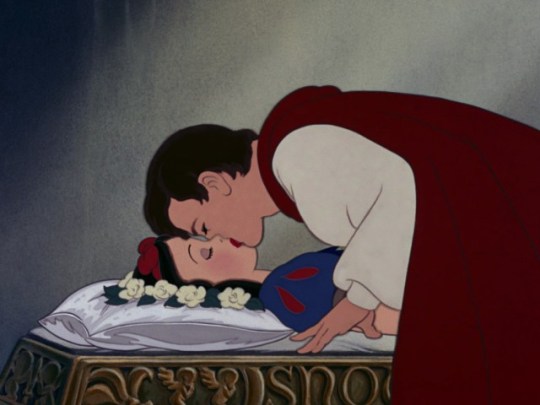

“Ah – “
“If you make ONE necrophilia joke, I swear I’ll take all the Adam Sandler movies off the Shelf.”
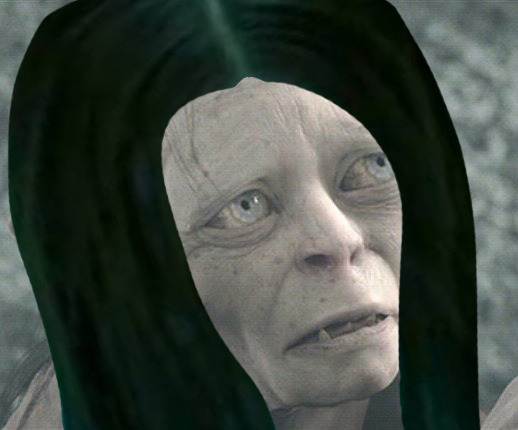
“Please, no!! I’ll have nothing to fully snark at!!”
The kiss does its work and Snow White awakens none the worse for wear. And since what doesn’t kill you makes you stronger, she’s immune to all poison ingested via deciduous fruit now. That’ll make ruling the kingdom she’s inherited from her stepmother and disappeared father much easier. And for those of you complaining how a magical kiss is a cop out, trust me, it’s better than how the original fairytale resolved it.

“Somewhere my love lies sleeping, and here she is! I’ll pay you dwarfs anything to let me take her back to my castle and keep her there as a memento of our tragic love.”

“This had better be worth it, she weighs a freaking ton!” “OHH, there goes my hernia!” *BANG*

*HACKHACKCOUGHHACK* “Thanks for the Heimlich, guys, damn apple’s been stuck in my throat for a year!”

“Seriously, I’m not making that up. Plus, they invite the Queen to the wedding and force her to dance to death in red-hot iron shoes.”
Everyone rejoices, Snow White says goodbye to the dwarfs, and the Prince leads her on his horse to his shining palace in the clouds. They all live happily ever after, the end.
And that’s Snow White and the Seven Dwarfs, the very first animated Disney movie. Do I believe the American Film Institute’s claims that it’s the best animated film of all time? Well, to be honest, no. The main characters aren’t as developed compared to future Disney protagonists, the animation goes noticeably off model at times, and it’s got one foot stuck in the style of the Silly Symphonies shorts that came before.
Is it the most influential animated film, however? Of course! Without it animation wouldn’t be as mainstream as it is today. While the formula has been updated and subverted through the decades, most animated features follow a similar blueprint – a dastardly villain, fun side characters, memorable music, distinct visual flair, fighting, torture, true love, miracles, you get the picture. We wouldn’t have any of that without Snow White. Once upon a time, this movie was the Star Wars of its era; a groundbreaking, audience-thrilling blockbuster that changed the way people looked at movies. Part of that is because Snow White taps into an emotional simplicity in a manner few films are able to. It relies more on providing an emotional catharsis than logic, inviting us to experience the story as we once did through the eyes of a child, and in doing so captures the essence of a classic fairy tale.
In fact, looking at the ripple effect of how movies can influence one another across the years, Snow White ranks among one of the most influential movies made in general. Apart from Disney you can see its echoes in The Wizard of Oz, Gulliver’s Travels, Citizen Kane, and yes, the original Star Wars. Even Sergei Eisenstein, the man who revolutionized filmmaking with freaking Battleship Potemkin, declared Snow White to be the greatest film ever made.
…So why did Walt Disney come to hate it later on in life?
Every movie that’s met with acclaim and accolades is bound to hit some backlash for one reason or another. Maybe it’s been overhyped, or time hasn’t been that kind to it. For Walt, Snow White leaned into the latter as his artistic prowess grew. No creator likes looking at their past work because it’s easier to notice the flaws when viewing it through a more experienced eye (believe me, I know). That, and no matter what he did, it seemed impossible to escape from Snow White’s shadow. For decades everything he created was inevitably compared to it.
Hmm, the animation and music are an improvement, but what it’s really missing are some dwarfs.
Hmm, the creativity leaps off the charts, but if only the score had lyrics that rhyme with the words “shmeigh shmo”.
Hmm, it’s breathtaking and magical, but it’d be perfect if you could just sit and watch it for eighty minutes without interacting with any of it at all.
Hmm, it’s practically perfect in every way, but…um…uh…more dwarfs, dammit!!
Thankfully Walt’s displeasure mellowed after some time. As for Snow White, she’s still rightfully hailed as the one that started it all. The art is iconic, the characters are unforgettable, and virtually all the songs are Disney gold standards for a reason. Well before Rodgers and Hammerstein changed the face of musical theater by having the score and the book go hand in hand, Snow White did it first in the cinemas. In fact this was the first movie to ever have a commercially released soundtrack, another confounded idea Hollywood wouldn’t understand for quite a while. Though time may temper with modern expectations, Snow White is as much a classic now as it was destined to be eighty years ago, and nothing can touch it. It still is the fairest one of all.

“HA! Try to remake/sequelize THAT, Disney!”
“Excuse me, is it too late to join this review?”

“I’m sorry, who are you?”
“Oh, where are my manners? I’m Snow White’s sister, Rose Red.”

“…You sure you’re not just a color-swapped OC clone from Deviantart?”
“Of course I’m not, silly! I’m in the fairytale and everything! Well, not THE fairytale per se, but there is one titled ‘Snow White and Rose Red’ where we’re siblings.”

“Checks out. They’re technically related.”

“Okay, but what are you doing here?”
“I was just wondering when you were going to discuss my upcoming movie!”

“Your…movie?”
“Oh yes! It’s going to be Disney’s Snow White all over again but from MY point of view! Isn’t that exciting?”

“But…but you weren’t even in Snow White and the Seven Dwarfs.”
“I know! I was off to the side doing…well, you’ll have to wait and see! The lady who wrote that Gone Girl knockoff that takes place on a train and the Indecent Proposal remake is doing the screenplay and she is just delightful!”

“…Excuse me for one moment.”
“Oh dear. Have I said something wrong?”

“It’s ok. This is just the part of the review where Shelf goes berserk.”
youtube
Thank you for reading! If you enjoyed this review, please consider supporting me on Patreon. Special thanks to Amelia Jones and Gordhan Ranaj for their contributions.
You can vote for what movie you want me to look at next by leaving it in the comments or emailing me at [email protected]. Remember, you can only vote once a month. The list of movies available to vote for are under “What’s On the Shelf”.
Also, Patreon supporters get extra votes among other perks. If I reach the goal of $100, I can get back to reviewing animated series! I’m at the halfway mark right now, so please consider supporting me if you’re able.
Artwork by Charles Moss.
Most screencaps courtesy of animationscreencaps.com.
February Review: Snow White and the Seven Dwarfs (1937) If there's a reason why we're able to recall the story of Snow White from memory, and why said princess is usually depicted with short hair, a cute bow and surrounded by woodland fauna, look no further than Disney.
#1930&039;s#animated#animated feature#animated movie#animated movie review#animated musical#animation#bashful#buddle-uddle-um-dum#castle#classic#classic disney#classic Hollywood#dark forest#diamond mine#Disney#disney animated#disney animated feature#disney animated movie#disney animation#disney princess#disney review#disney villain#disney villain death#doc#dopey#dwarfs#evil magic#evil queen#fairest one of all
3 notes
·
View notes
Text
Some Thoughts on Tom & Jerry: The Movie
A new Tom & Jerry live-action/CGI hybrid movie is on the way, but the duo’s initial outing on the silver screen in a feature makes for amusing viewing after almost 30 years.
Tom & Jerry were, of course, born on the big screen. Appearing in a raft of shorts for Metro-Goldwyn-Meyer (MGM) in the nineteen forties and fifties. That life in shorts was shared with their Hollywood colleagues who similarly didn’t receive their feature debut for many decades after short films had vanished from cinemas. The timing of this film comes a short time after the release of Who Framed Roger Rabbit! and rode a wave of nostalgia for cartoons from the Golden Era.
I remember seeing it in the cinema at the time and thinking it was a pretty good film. Not a favourite, but enjoyable. Watching it almost thirty years later is an altogether different experience. Not only am I older, but animated filmmaking has changed almost beyond recognition. The film now seems like an curious oddity from a different time.
"You talked!"
Tom & Jerry: The Movie (T&J:TM) faces an uphill battle based on the concept alone. Taking characters beloved for their adventures in short films and stretching them to the amount of time that’s expected of a feature is, well, difficult. Roger Rabbit sidestepped the issue through original lead characters and cameos for everyone else. Tom & Jerry wouldn’t be so lucky.
The producers got around this by simply having the characters talk. Now in fairness, they had a lot less dialogue than I remembered and to the producer’s credit, it is a restrained amount all things being considered. Any dialogue however, was going to break a fundamental feature of the original shorts who’s genius was that they dispensed with all dialogue aside from Tom’s occasional yells. So one wonders if that sinks the ship before it’s even left the shipyard and to a certain extent it does.
That being said, it’s necessary to consider everything in context. This film was released in 1992/3 when animated films were stuck in a rut of sorts. Disney’s renaissance was well under way, but the reasons were not yet so obviously unique to that company. Independent animated features instead copied one of the more noticeable traits by going the musical route. T&J:TM exemplifies this. The songs are not ‘out of place’ per se; they’re just another aspect of the film that yanks the characters further away from their origins.
The story is, what I would consider, pedestrian and aiming towards the formulaic. Tom & Jerry, it was clearly felt, could only carry a film by themselves for so long and thus, Robyn enters the scene and provides the necessary problem the characters need to solve. Orphans must have been trendy in the late 80s and early 90s as films such as Aladdin, and All Dogs go to Heaven attest to.
One facet of the plot is the prominent focus on money and the destructive effects that greed can have. Money drives all the antagonists in various ways in contrast to the themes of friendship and loyalty that drives the protagonists. Interestingly, this theme is all the more potent with recent recessions, COVID, and economic pressures faced by many while those at the top gain ever more.
The animation is OK. That’s about all I can say. The crew clearly aimed for the energy of the original shorts and succeeded for the most part. It’s just that overall quality is clearly second tier but on par for most other animated films that weren’t Disney’s.
Both William Hanna and Joe Barbera were alive when this film was released with the former being a creative consultant. To the filmmakers credit, the degree of loyalty to the original shorts while trying something new is admirable. Later results aren’t as good. A new, live-action/CGI hybrid is on the way, but the duo’s initial outing on the silver screen in a feature makes for amusing viewing after almost 30 years. The odd gag is reused outright, but it’s the ethos that carries through and evolved. The film makes good use of incorporating scenes reminiscent of the shorts into the wider story without making them feel like set pieces.
In the end, what brings the film down is that it was released perhaps half a decade too soon. In hindsight, Toy Story was groundbreaking for far more than its CGI. Conceptually it broke the mold for what animated films should be with its writing, humour, and most importantly, its lack of songs. T&J:TM follows the old mold and it shows. Had the film been released in 1997, we would have seen a different film; perhaps in a good way, perhaps in a bad way. Optimistically, I hope it would have been better and benefited from knowing that Disney’s success was down to more unique factors and that Toy Story showed there was a different path to take.
Conclusion
I don’t hate this film. I don’t love it either, but therein lies the quandary. T&J:TM is stuck between a rock and a hard place. It valiantly tries to take characters who’d never been on screen for more than 8 minutes and make them survive for more than 90. It breaks one of the cardinal rules of said characters not out of choice, but out of necessity. It came out too soon to be able to take a risk, but ended up being too generic to stand out.
With the release of a new film that combines live-action with CGI as a way of bypassing the dialogue dilemma, comparing both films will make for good discussion.
Originally published at https://animationanomaly.com/2021/02/16/some-thoughts-on-tom-jerry-the-movie/
0 notes